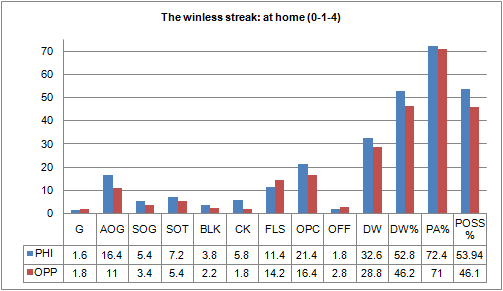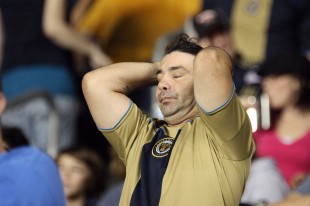Photo: Paul Rudderow
In the past two home games, the Philadelphia Union recorded 42 attempts on goal—including 13 shots on goal, 18 shots off target and 11 blocked shots. They also had 12 corner kicks, 46 open play crosses, a duels won percentage of 52.5, completed 691 of 892 passes for a passing accuracy of 77.5 percent, and averaged 61.3 percent of possession.
Yet, they gave up four goals in a single half and couldn’t score in 90 minutes against an expansion team at home, managing a grand total of two points. Since their last win against New England on July 17, the Union are 0–3–5.
What’s going on?
The winless streak at home
 One of the most frustrating things about the winless streak is that it continues despite the fact that the majority of the games have been played at home. Equally frustrating is the fact that, on average, in every offensive category except for one, the Union have outperformed the opposition at home. The Union have recorded significantly more attempts on goal and shots on goal, corner kicks, open play crosses, fewer offsides calls, duels won, as well as superior duels won, passing accuracy and possession percentages. The only category in which they have, on average, performed worse than the opposition is in goals—more have been allowed than have been scored. That the goal difference between the Union and their opponents at home is so small—just .2 percent, one goal—only shows how a single moment of better finishing could have turned the loss into a draw or any of the four draws into a win.
One of the most frustrating things about the winless streak is that it continues despite the fact that the majority of the games have been played at home. Equally frustrating is the fact that, on average, in every offensive category except for one, the Union have outperformed the opposition at home. The Union have recorded significantly more attempts on goal and shots on goal, corner kicks, open play crosses, fewer offsides calls, duels won, as well as superior duels won, passing accuracy and possession percentages. The only category in which they have, on average, performed worse than the opposition is in goals—more have been allowed than have been scored. That the goal difference between the Union and their opponents at home is so small—just .2 percent, one goal—only shows how a single moment of better finishing could have turned the loss into a draw or any of the four draws into a win.
The Union’s goals/shots on goal percentage over the last eight games at home is 30 percent compared to 28 percent over the first 19 games, but the 30 percent figure is somewhat inflated by the four goal New England game. The Union’s opponents’ goals/shots on goal percentage during the winless streak is an astonishing 53 percent (nine goals from 17 shots on goal), compared to 35 percent over the first 19 games.
Despite the above, the Union’s save percentage at home during the winless streak has actually improved from 59 percent over the first 19 games to 67 percent. So to, however, has their opponents’, up to 71 percent from 69 percent.
The winless streak on the road
 After the auspicious road win in the season opener at Houston, the Union have stumbled on the road, going W–L–L–L–W–D–L–D–D–W before the start of the winless streak. During the streak, they have gone D–L–L for an overall road record of 3–6–4.
After the auspicious road win in the season opener at Houston, the Union have stumbled on the road, going W–L–L–L–W–D–L–D–D–W before the start of the winless streak. During the streak, they have gone D–L–L for an overall road record of 3–6–4.
The relative dominance the Union have shown at home in the various statistical categories during the winless streak has obviously not been on view when the Union plays away, where they have better average numbers than their opponents only in corner kicks (scoring one goal from a corner kick on the road in the loss to Columbus), open play crosses, offsides and duels won. Remarkably, the Union’s shots on goal average away is exactly half of what their average is at home. However, comparing the goals/shots on goals percentages, the away percentage is actually better. At home, the Union have eight goals from 27 shots on goal, a goals/shots on goals percentage of 30 percent. On the road, the Union have three goals from eight shots on goal, a goals/shots on goals percentage of 38 percent. This is actually better than their opponent’s goals/shots on goal percentage, which comes in at 31 percent (5 goals from 16 shots on goal). For their opponents, the goals/shots on goals percentage works out to 31 percent away compared to 53 percent at PPL Park.
Looking at the save percentage, the Union’s 56 percent is topped by their opponents’ 63 percent. In comparison, the Union’s save percentage on the road for the first 19 games was 71 percent while that of their opponents was 60 percent.
The winless streak overall
 When the home and away average numbers during the winless streak are combined, the Union once again outperforms their opponents in attempts on goal, shots on goal, corner kicks, open play crosses, duels won, duels won percentage and possession and record fewer fouls and offsides.
When the home and away average numbers during the winless streak are combined, the Union once again outperforms their opponents in attempts on goal, shots on goal, corner kicks, open play crosses, duels won, duels won percentage and possession and record fewer fouls and offsides.
Where the Union are outperformed is in passing accuracy and, of course, goals. Overall, the Union have scored 11 goals while allowing 14, a goals scored average difference of .5. Once again, a better finish here, better defense or a better save there, and the winless streak never happened.
Looking at the overall goals/shots on goal percentage during the winless streak, the Union comes in at 34 percent compared to their opponents’ 42 percent. Over the first 19 games, the Union was at 31 percent while their opponents’ goals/shots on goal percentage was 34 percent. The Union’s save percentage is 62 percent during the winless streak while their opponents’ save percentage is 67 percent. In the first 19 games the Union’s save percentage was 65 percent, the same as that of their opponents.
What’s going on?
Over the first 19 games, the Union outscored their opponents 24 to 16. During the winless streak, the Union have been outscored 11 to 14.
Here’s an interesting set of statistics. Before the winless streak began, the most goals allowed by the Union in a game was two, with the Union allowing two goals four times in the first 19 games. In every other game, the Union held their opponent scoreless (seven times) or to one goal (eight times). During the eight game winless streak, the Union have allowed two or more goals five times, one goal one time, no goals one time. When allowing two goals in the first 19 games the Union’s record was 2–1–1. When allowing two goals in the last eight games, the Union’s record is 0–3–2.
In comparison, in the first 19 games the Union were held scoreless six times, scored one goal eight times and at least two goals five times. During the winless streak the Union were held scoreless once, scored one goal five times and at least two goals twice. When the Union scored at least two goals over the first 19 games their record was 4–0–1 . When they scoring at least two goals over the last eight games, their record is 0–0–2.
What’s going on? While the Union have improved their goals/shots on goals percentage during the winless streak from 31 percent to 34 percent, the improvement shown by their opponents has been larger, from 34 percent to 42 percent. And while the Union’s save percentage has declined over the winless streak from 65 percent to 62 percent, that of their opponents has improved from 65 percent to 67 percent. Quite simply, while the Union offense has shown some signs of life, the Union goal has become more vulnerable. And, as we’ve made clear in our look at the Union defense and goalkeeping, this vulnerability predates the Harvey trade. Meanwhile the signs of life shown by the offense remain as inconsistent as they have been throughout the season.
Despite the eight game winless streak, the Union find themselves in third place in the Eastern Conference. After eight games of bending, only seven games remain to show whether they are primed to snap back or break.



Comments